Street Lamps / Street Lights
Baltimore would obtain street lights by order of the police department. These lights were oil lamps, and the police gave the orders to light, extinguish, and maintain them.
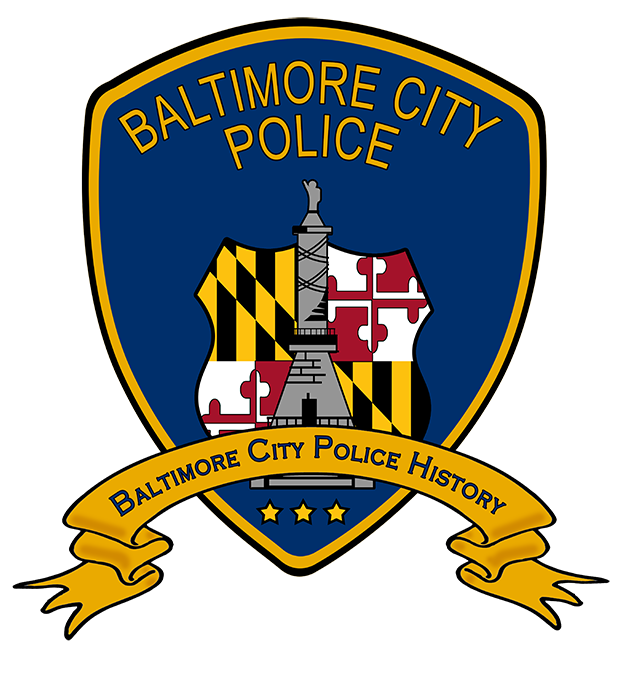
Baltimore Street Lamps and Street Lights
1784 – Baltimore would obtain street lights by order of the Police Department. These lights were oil lamps, and the police gave the orders to light, extinguish, and maintain them. It was not as obvious to the public as it was to the panel of commissioners and to the council of city hall, but the lighted streets in Baltimore were a deterrent that prevented and decreased crime in and around "Mob Town.". At first, many of the ideas and theories of the Panel of Commissioners and our Marshals were often shot down or put off until they either died in committee or were funded privately. Still, many of these ideas went on to become the norm in law enforcement throughout the country and around the world. Furthermore, state legislatures would eventually pay for, endorse, and approve these ideas.
1816 – 7 February 1816, After just 34 years, the Baltimore Police turned the maintenance of the street lights over to Peale's Gas Light Company of Baltimore. The first gas street lamp in America was lit at the corner of N. Holliday St. and E. Baltimore St., where there still stands a replica of this light as a tribute to the rich history of our city, our police department, and the initiation of gas lighting in this country. As a side note, the first home to have a gas light was the residence of William Henry, a coppersmith located in the 200 block of Lombard Street.
1889 – March 28, 1889 Ten incandescent electric lights, which will illuminate the heretofore gloomy pathway in Druid Hill Park leading from the Clipper Gate to the walk from the Mansion House to the main entrance on Madison Ave., were lighted last night (March 28, 1889) for the first time. The lamps are placed upon cedar posts about the height of a street gas lamp and are lit simultaneously by the turning of a lever in the gatekeeper’s house at Druid Hill's entrance to the park. Street lamps initially began in this country at the suggestion of the Baltimore Police Department when they used oil lamps that would be lit, extinguished and maintained by Baltimore’s Police, The year was
1784 – It was not as obvious to the public as it was to the panel of commissioners and to the council of city hall, but the lighted streets in Baltimore were a deterrent that prevented and decreased crime in and around "Mob Town.". At first, many of the ideas and theories of the Panel of Commissioners and our Marshals were often shot down or put off until they either died in committee or were funded privately. Many of these ideas would go on to become the norm in law enforcement throughout the country and around the world. Furthermore, our state legislatures would eventually pay for, approve, and endorse these ideas.
Street Lights: The history of street lighting in the United States is closely linked to the urbanization of America. Starting in 1807, Pall Mall St. in London became the first street in the world to have gaslight illumination. The first city in the United States to use gas street lights was Baltimore, starting in 1817. Before incandescent lamps, candle lighting was employed in cities. The earliest lamps required that a lamplighter tour the town at dusk, lighting each of the lamps. Much of the maintenance, designation of locations, lighting, and extinguishing were directed by the Baltimore Police Department.
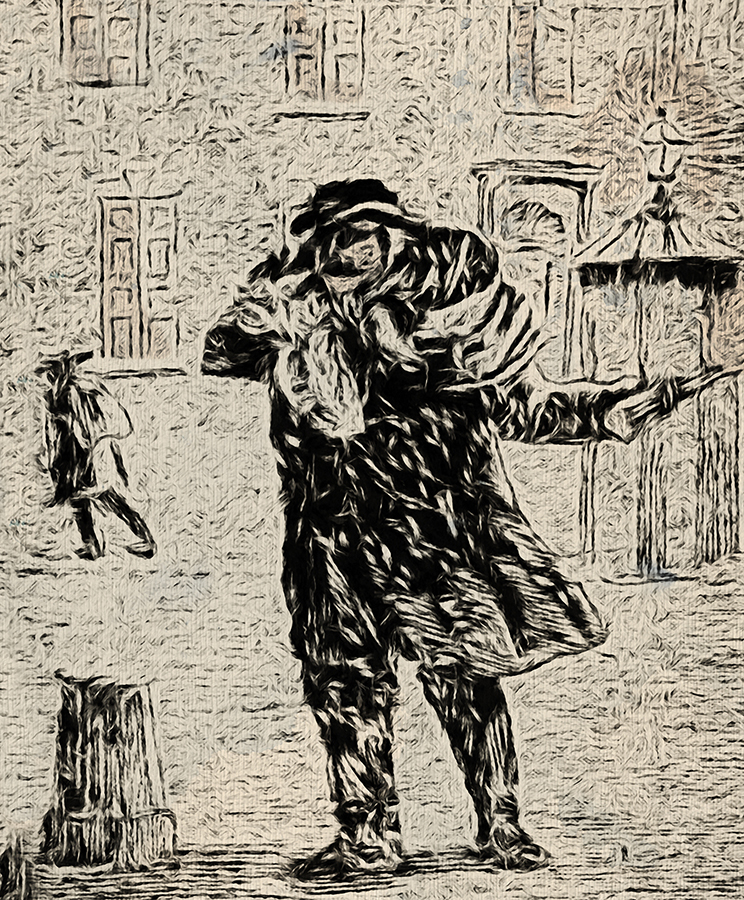
From a print in the Maryland Historical Society Collection
A Baltimore "Night Watch" in the Days Before the
Baltimore City Police Department was Officially Organized
18 October 1925
Old Oil Lamps Were Cities and Streetlights Once
Modern Electric Lights and Long Stride from Methods of Illumination of Highways In Bygone Days The installation of moderate electric street arcs on additional Baltimore thoroughfares recalls early methods of illuminating highways here and the changes that have taken place. Since Prometheus stole the heavenly fire from the hearth of Zeus, mankind has sought to illuminate the gloom of night by means of artificial illumination. The introduction of the lamp, historians tell us, marked the first stage of man’s advancement towards civilization. It explains, too, why the lamp is so constantly used in art as a symbol of spiritual and educational development. Lamps were in common use as long as 7000 or 5000 years B.C. Before Christ
Throughout the world, street lighting was not common until comparatively recent times. Everyone had to carry their own light, or, as in the case of London and here in Baltimore, those with the means would hire someone to carry a lamp for them. This job began in London and was most commonly known as a “link boy.” A torch of tow, pitch, or other inflammable substance lit the way in the streets. It was a common custom in Great Britain. Dickens speaks of it, “and the link boy is still known.”
Lighted Lanterns
In 1415, lanterns provided the first source of illumination in London. Gas lamps were used on the streets from 1694 to 1786. Liverpool adopted gas lighting nine years later. The burning of coal oil, or kerosene, and household lamps was not introduced until after the manufacture of gas. Baltimore street lamps before 1820, therefore, were unquestionably supplied with whale oil. One of the high spots in Baltimore’s history was in 1816, when Rembrandt Peale invited the citizens of Baltimore to witness the illumination of his museum on Holiday Street with gas. As a result of this exhibition, Baltimore was the first city in America to inaugurate a gas company. City Hall is now occupying the former museum site. The earliest streetlights in Baltimore were due to individual effort. Before the incorporation of the city, tallow candles and whale oil were illuminated. An ordinance, approved April 3, 1797, states: “whereas the justices of Baltimore contracted with a certain Jacob Lewis Betlinger for erecting 305 lamps and for the supply of the same with oil and lighting them until the first day of January 1798.” Jacob Lewis Betlinger served under the commissioners of the watch (Baltimore police).
Astral oil, also Known as Whale oil, was Used
This ordinance confirms the insurance of the one man in Baltimore whom the writer found informed concerning what lumen it burned and Baltimore’s streetlamps prior to the introduction of gas. He said that whale oil, known as astral oil, produced these early lights. The earliest municipal lighting of Baltimore streets eventually was in connection with the establishment of the night watch [Baltimore police]
In 1775, a town meeting was held to appoint town guardians. Each person capable of duty under the organization then signed an agreement. This bound him to conform to police regulations adopted by the general meeting of citizens and sanctioned by the town commissioners. He also promised to attend personally when summoned to serve as a watchman or provide a substitute acceptable to the committee. This committee had some functions of the present-day police commissioner; the town was divided into districts. A company commanded by a captain of the watch was appointed in each. The first captains to be appointed were Capt. James Calhoun, of the First District; George Woolsey, of the Second District; Benjamin Griffith, of the Third District; Barnett Eichelberger, of the Fourth District; George Lindenberg, of the Fifth District; and William Goodwin, of the Sixth District. Isaac Vanbidder, with two assistants, was Capt. at Fells Point
Hours Called Allowed
Each captain had a squad of 16 men, with every inhabitant being enrolled and taking his turn. The man was on the watch patrol from 10 PM until the break of the day, calling the time every quarter of an hour. This service proved inefficient, however. The Maryland General Assembly passed an act in 1784 "for the establishment of a night watch and the erection of lamps in Baltimore town" when William Paca served as governor of Maryland. The assembly contended that for the preservation of the people and property of the inhabitants, for the preservation of fires, burglaries, and “other outrageous acts,” the commissioners of Baltimore town were authorized to contract with proper persons to “erect any number of lamps that, in their judgment, were necessary.” People were to be engaged in the “lighting, trimming, and snuffing” of them, and material was supplied for maintaining the lamps and keeping them in repair. It was pointed out and asked that “in lighting the streets, lanes and alleys in the nighttime were of very great importance.” The commissioners were given a free hand in bringing about the change.
Commissioners were to set down in writing where stands of watches [police] should be placed, their designated rounds, and the number of times they should cover them each night. A printed copy of these instructions was given to each watch. A constable was also appointed to see that the night watches perform their duties. In case of need, the night watch could make arrests. In the event of a fire, the watches were directed to notify each other and the inhabitants of their respective districts. Then they were expected to return to their individual stands, “the better to discover any other fire that may happen, as well as to prevent any burglaries, etc.” Penalties were severe for the extinguishing of the lights or the breaking down or destruction of lamps or century boxes willfully.
A fine of 3 pounds for each offense was assessed. If the damage was the result of an accident, the offender would be subject to the same forfeiture if he neglected to report it or pay for the necessary repairs. Fines went to keep up the lighting system. There may still be at least one picture of an early-night watch of Baltimore. Clad in a great coat, with hat and head envelopes in a muffler, and wearing high boots, he stands. In his hand is a torch. Nearby is a century-old box with a lighted lamp on top. 13-century boxes were erected throughout the town and supplied with small stoves for the comfort of the night watches.
Sunday Was Holiday
Early lamplighters in Baltimore were expected to light, extinguish, and clean lamps. Sunday seems to have been a day of rest for them. On June 13, 1816, Rembrandt Peale advertised “gas lights, without oil, tallow, wink, or smoke,” showing that tallow candles with whale oil, then called astral oil, were in common use. It was this astral oil that burned in the lamps lighting Baltimore streets. The advertisement appeared in connection with Mr. Peale’s Museum. A Chronicle pertaining to Baltimore and published in 1833 described the “gas factory” of that date. “A company formed for the purpose of manufacturing gaslights to illuminate the streets, stores, and private buildings is carrying on the business very successfully. The works are situated at the southwest corner of North and Saratoga streets, where they make daily 58,000 ft.³ of gas, having five guest meters at that station containing 30,000 ft.³ and one at a new station on Concorde Street, near the Jones Falls, containing 34,000 ft.³. This gas is conveyed in iron pipes through the streets and in tubes of copper to the lamps.
Pipes Eleven Miles Long
“The whole distance to which the pipes at present extend is upward of eleven miles." “This establishment is of considerable importance to the community. From the pit coal used to produce the gas, a quality of tar is obtained, which is sold at three dollars a barrel, a lower rate than the tar extracted from pinewood. Though it possesses a quality which the other has not, that of preserving the bottom of vessels from injury by the worms, as well as being peculiarly adapted to other purposes, such as painting roofs of houses, paneling, etc. And further, the residue of the coal, cold Coke, is a valuable substitute for charcoal and pit coal, being free from smoke or any deleterious gas; it sells at $.10 per bushel.”
Mr. Peale’s enterprise and initiative were the immediate cause of Baltimore’s being the first city in America to inaugurate a gas company and introduce guest lighting in its streets. According to George B. Cortelyou, Baltimore was also the first city where guest meters were manufactured, with Samuel L. as the manufacturer. The Mayor and City Council of Baltimore approved an ordinance on June 11, 1816, allowing the Baltimore gaslight company to more effectively light the city streets. The company obtained its charter on February 5, 1817, and the incorporators were Mr. Peale, William Lorman, James Mosher, Robert Kerry Long, and William Gwynn. The charter was obtained through the legislature. 100 shares were set apart to be assigned to Rembrandt Peale as compensation in full for the privileges of using the invention of Dr. Benjamin Kugler, of Philadelphia, for manufacturing, collecting, and using carbureted hydrogen gas. The company got fairly established in 1820, with William Lorman as its first president.
The first public building lighted with guests by the company was the old Belvedere theater, at the northwest corner of North and Saratoga streets. The first private residence to be illuminated with gas was the home of Jacob J. Cohen, 1 North Charles St. The second was that of his neighbor, Hugh Birkhead. The Belvedere theater was just across the street from the first gasworks. Since the beginning of the manufacture of gas in this city, the supply never has failed—not even during the great conflagration of February 7thand 8th, 1904
![]()
End of the Baltimore Streetlight Era
4 Aug 1957
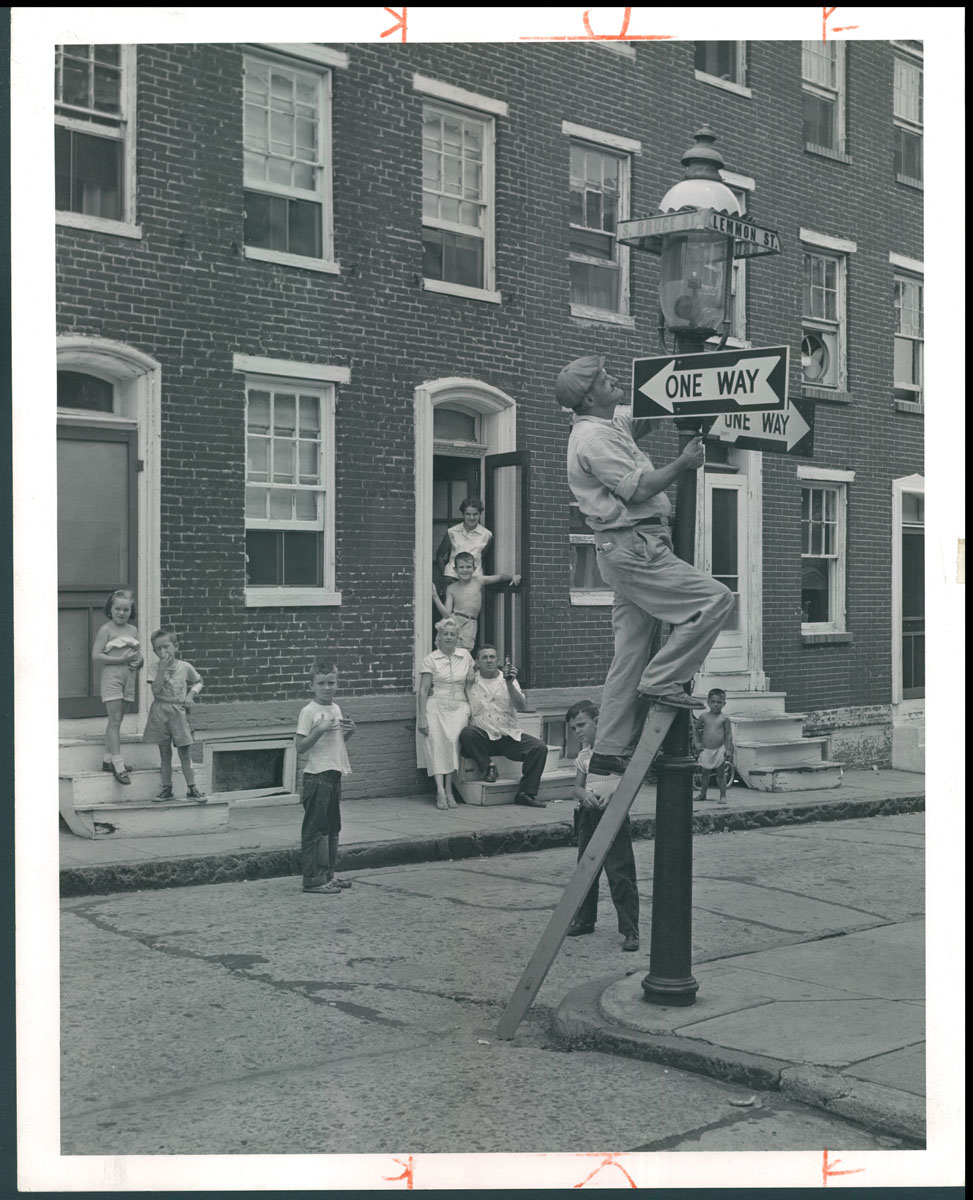
When Mayor D’Alessandro extinguished Baltimore’s last gas streetlight in 1957, he was giving a coup de Grace to an era that had for so long been dying that its allure was all but forgotten.
The time period was a lengthy one. Baltimore's streetlamps were the first in America to use gas lamps for illumination when it all started in 1817. This was the doing of Rembrandt Peale, the celebrated painter, curiosity collector, and scientific dabbler who kept Peale’s Museum on Holiday Street.
Peale had learned of the gas lamps on the early 1900’s streets of London, and he began experimenting. In 1816, he lit his museum with gas; the same year, he and a group of prominent citizens sold the city by chartering the Gas Light Company of Baltimore for the purpose of putting gas lamps along the streets. The first light was erected on the northwest corner of Market and Lemon, now Baltimore and Holiday Streets. It was lit ceremoniously on February 7, 1817.
As bright as the light seemed to them, Baltimoreans were a little skeptical. The night streets had always been a problem. In the early days of the town, citizens lit their own way along the muddy streets or paid someone to carry their lanterns for them. One of the reasons for the establishment of the Night Watch (the ancestors of the Baltimore Police Department) was to ensure more lanterns—and hence less crime and fewer accidents.
In 1784, the town fathers talked about creating lampposts; in 1797, they retained one Jacob Lewis Betlinger to set up, maintain, and light 305 lamps. Whale oil was known as "Astral Oil," which was the fuel for these.
Even after Peale’s company was founded, Baltimore was not well lit. It took time and money to run mains from the coke plant at Guilford and Saratoga Streets to the lampposts, and time and money to put these up. As the years went on and the city expanded, lights were placed on the new streets. But the supply never kept pace with the demand or the need.
Indeed, it was not until 1879 that the city appointed a street lighting official and created a department. He and his department went under the title of General Superintendent of Lamps, Inspector, and Sealer of Gas Meters.
The first is that Superintendent F. W. King reported to the Mayor in 1880 that he had placed red glass lenses on the lights closest to the fireplugs. He reported 4847 gas lamps and 990 gasoline lamps. The latter, along with kerosene lamps, lasted well into this century in alleys and remote areas where there were no gas mains.
In 1881, the first electric streetlamps were tried out; the superintendent was skeptical. He liked them better than gasoline lamps, though, because the latter “is a favorite target not only for boys but also for men to shoot and throw stones.” He feared to erect anything that would cost more only to become their next target for destruction.
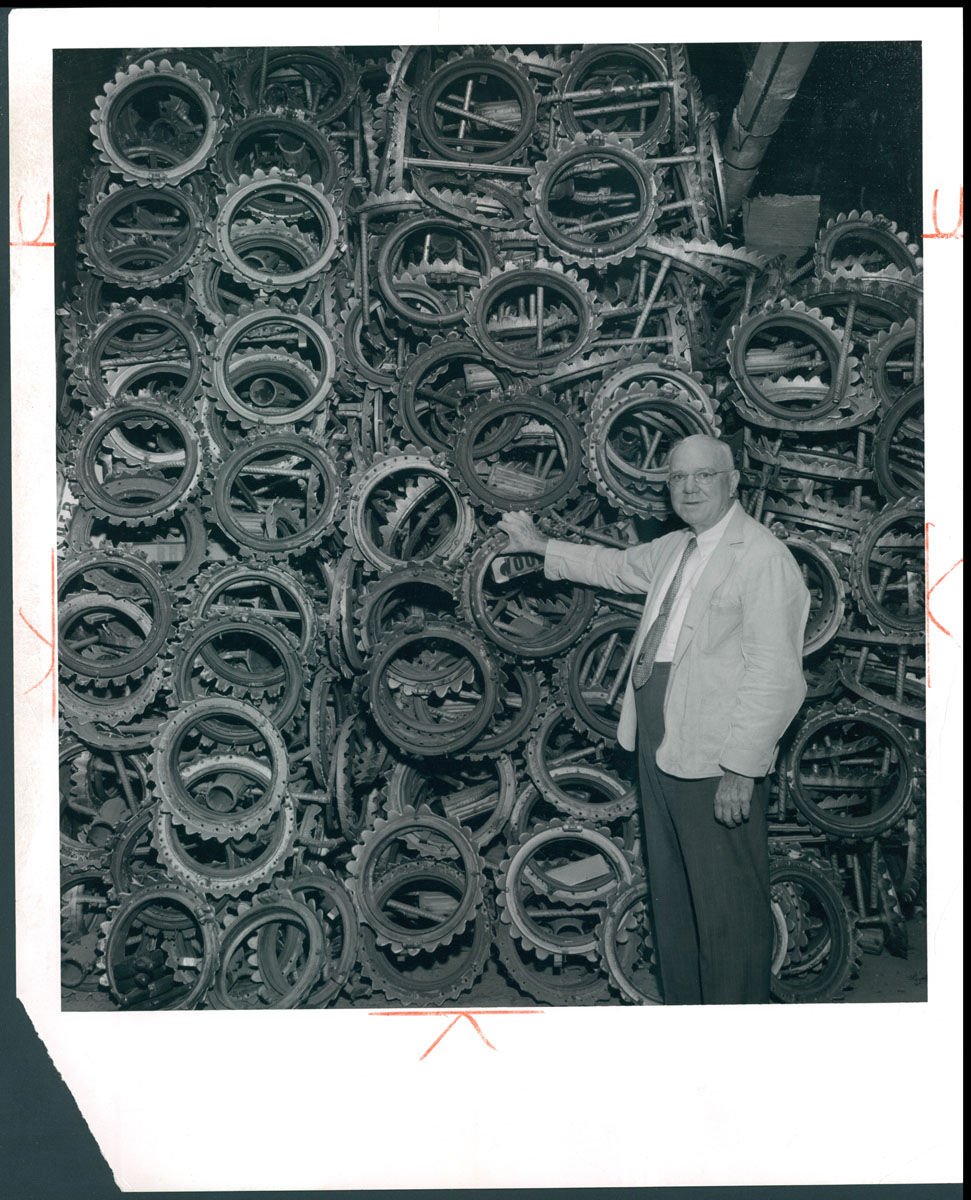 In 1889, W. Stewart Symington, grandfather of United States Senator Symington, took over. He had been a major in the Confederate Army and had served directly on Pickett’s staff; apparently, that did not prepare him for some of the vexatious aspects of his new job. If his annual reports are any indication, for one thing, the citizens were still howling about the department’s policy of leaving the gas lamp off on bright moonlit nights, a policy that was held to until almost the turn of the century.
In 1889, W. Stewart Symington, grandfather of United States Senator Symington, took over. He had been a major in the Confederate Army and had served directly on Pickett’s staff; apparently, that did not prepare him for some of the vexatious aspects of his new job. If his annual reports are any indication, for one thing, the citizens were still howling about the department’s policy of leaving the gas lamp off on bright moonlit nights, a policy that was held to until almost the turn of the century.
The lighting of the lamps annoyed people, too. They were lit either too early or too late. In 1890, there were 5301 gas lamps and nearly 800 gasoline lamps, with some 100 lamplighters employed.
Lamplighters got their jobs with political pull. The Ward Bosses recommended them to the superintendents of each of the six street lighting districts at the time, and the supers, who owned their exalted positions in politics, too hired the men.
At the turn of the century, in Baltimore, lamplighters made $32 a month. Most of them maintained a certain pride in their profession; they knew every family on their beat (this paid off well at Christmas time) and made a big thing of their skill. Each man carried a short letter, which he propped against the crossbars placed on the lamp pole for that purpose, and a second later, he was up the ladder, his head tilted back open to the glass box or globe. He then turned on the jet and put a match to it.
In the eighties and nineties, the Jets lit a Y-shaped tip, which gave off a flat light similar to that of a Bunsen burner. The gasoline and kerosene lamps were equipped with tanks, which the lamplighter kept filled. Sometimes the lights blew up when the men put a match to them.
Not all Lamplighters are conscientious; Superintendent Symington speaks of “derelictions,” suspensions, and firings. Until the front office caught them, some district superintendents made a good thing of graft and kickbacks from the gasoline suppliers.
In 1899, a change came about; the gas lamps were equipped with mantles. The light was better, but the services of the lighters were still required, not only to light the lamps at dusk and to turn them off in the morning but also to clean and repair the equipment as needed.
In 1912, the era of the lamplighter began to close; the Welsbach Corporation began installing time clocks in each lamp to turn the lights on and off. By 1915, the work was finished. Most of the street lights put in after World War I were electric. But new gas lights were erected until 1928. After that, a few were replaced with electric lights.
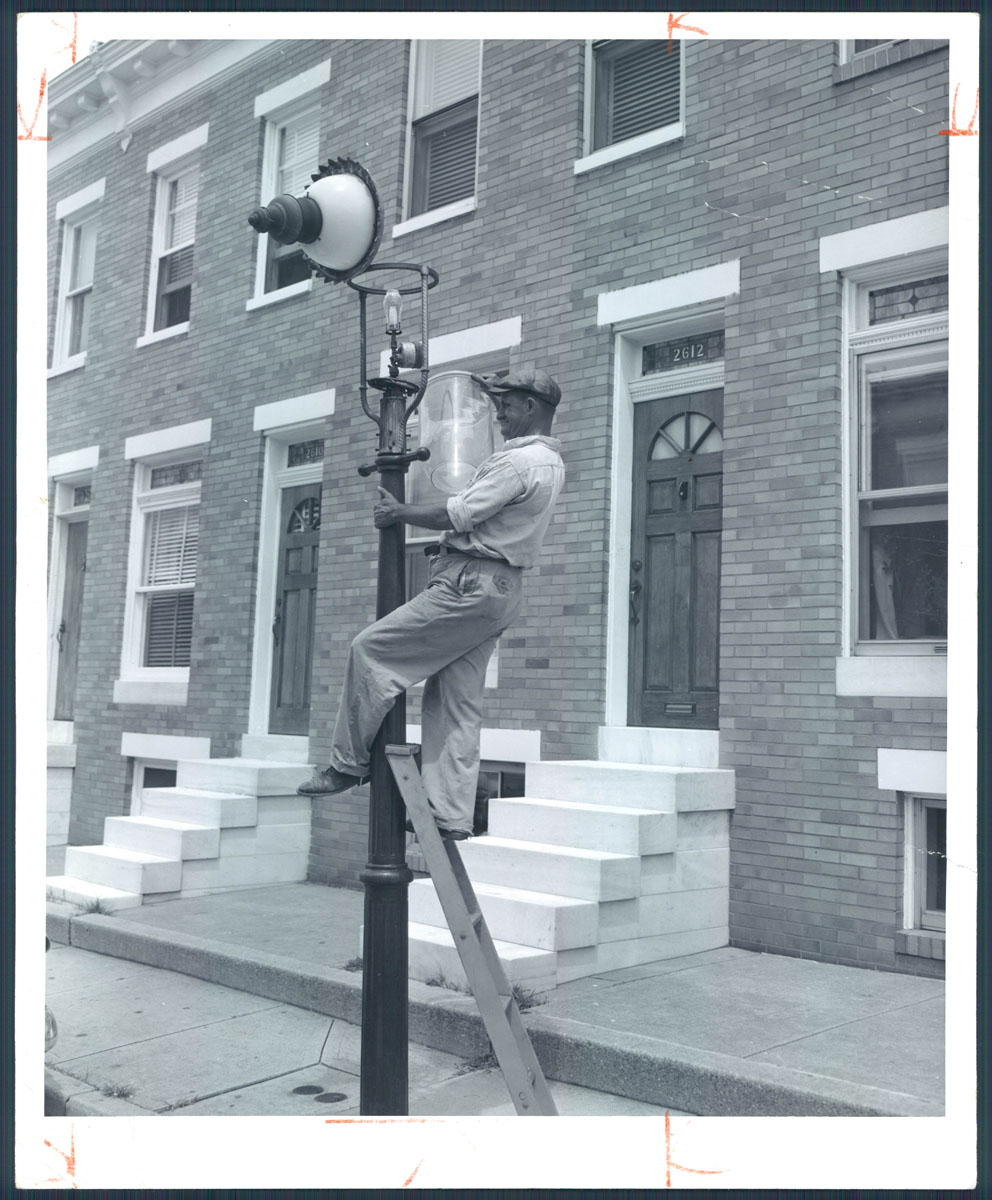
In 1946, the city embarked upon its $3,000,000 program to get rid of nearly 17,000 gas lights, which necessitated a working force of clock winders, global washers, and inspectors. At the time of these writings [4 Aug 1957], the last two of them were still at work; they were Walter Lindman and John Nichols.
In addition to all that time and trouble, of course, was the fact that the streets were not well illuminated; the strongest three-mantle gaslight supplied 150 candlepower, and the smallest residential district electric fixtures supplied to 250. On one secondary street, the candlepower of modern incandescent lights could be as high as 1500; the high-intensity mercury vapor lights, such as those that were initially installed on the Jones Falls Expressway when it was first built, were 2000 candlepower.
The responsibility for the switchover from gas to electricity had fallen on the lighting division of the city’s Bureau of Mechanical Electrical Services, which, under the aegis of Walter L. Buckingham, Superintendent of Lighting, has been working with a field force of 50 men from the Gas and Electric Company and various subcontractors that had to do some of the work too. “The jobs have been long and hard,” says Mr. Buckingham. “Every time a gaslight is taken out of service, it comes down, and so does the poll; then our men had to erect the new poll and light, and, of course, we had to excavate for the necessary electrical conduits.
“Snow, rain, and other rough weather, along with material shortages, have held us up from time to time. At the beginning of the year, they were faced with 900 gaslights; the last of them stood on 33rd St. from Hilen Rd. to St. Paul St., on Gwynns Falls Parkway from Reisterstown Road to Chelsea Terrace, and on University Parkway from Fortieth Street to Roland Avenue.” The last lamp is on the northwest corner of Fawn Street and Slemmer Alley. Mayor D’Alessandro snuffed the lantern out in a solemn ritual befitting the occasion.
![]()
Lamplighter Payroll out of Eastern District Police department
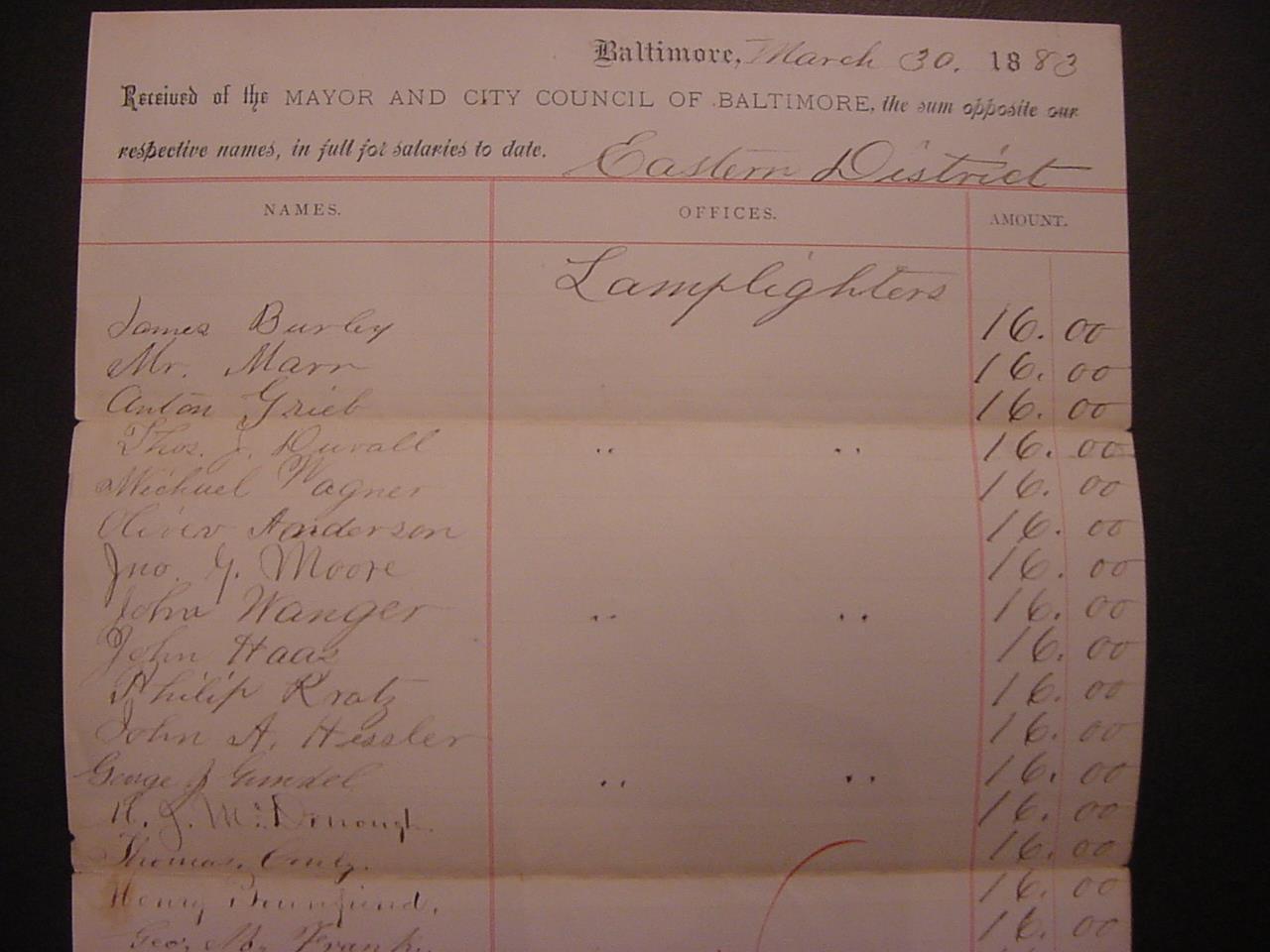
1883 Ledger for Payment made to Lamplighters out of the Eastern District
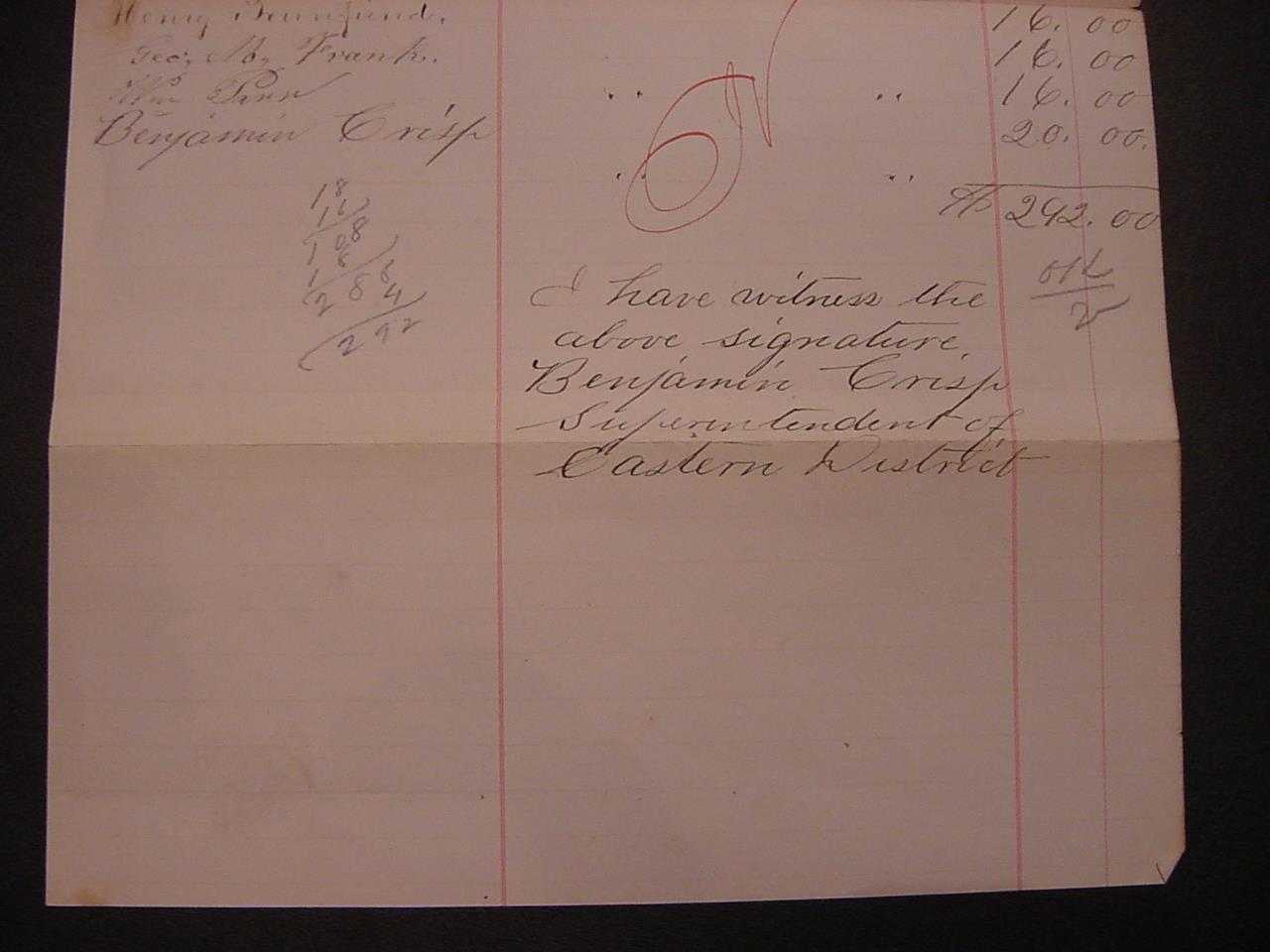
1883 Ledger for Payment made to Lamplighters out of the Eastern District
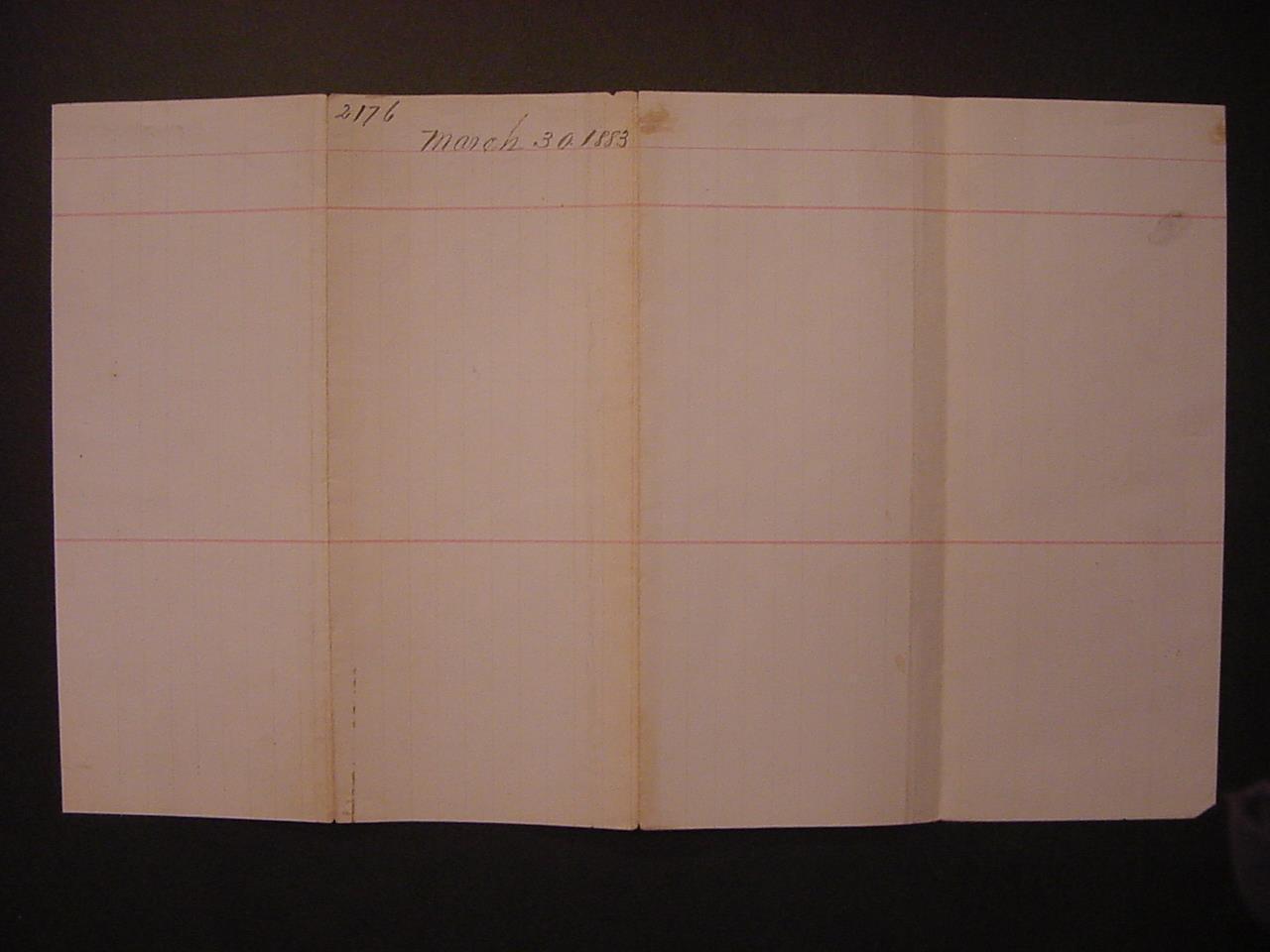
1883 Ledger for Payment made to Lamplighters out of the Eastern District
![]()
The Peoples Gas Company
Mayor & City Council Baltimore
10 July 1880
Baltimore, Maryland Mayor Ferdinand Latrobe 1880 Signed Check & Ledger
1880: The People Gas Company Baltimore
Street Lamp Maintenance Repair Upkeep & Costs
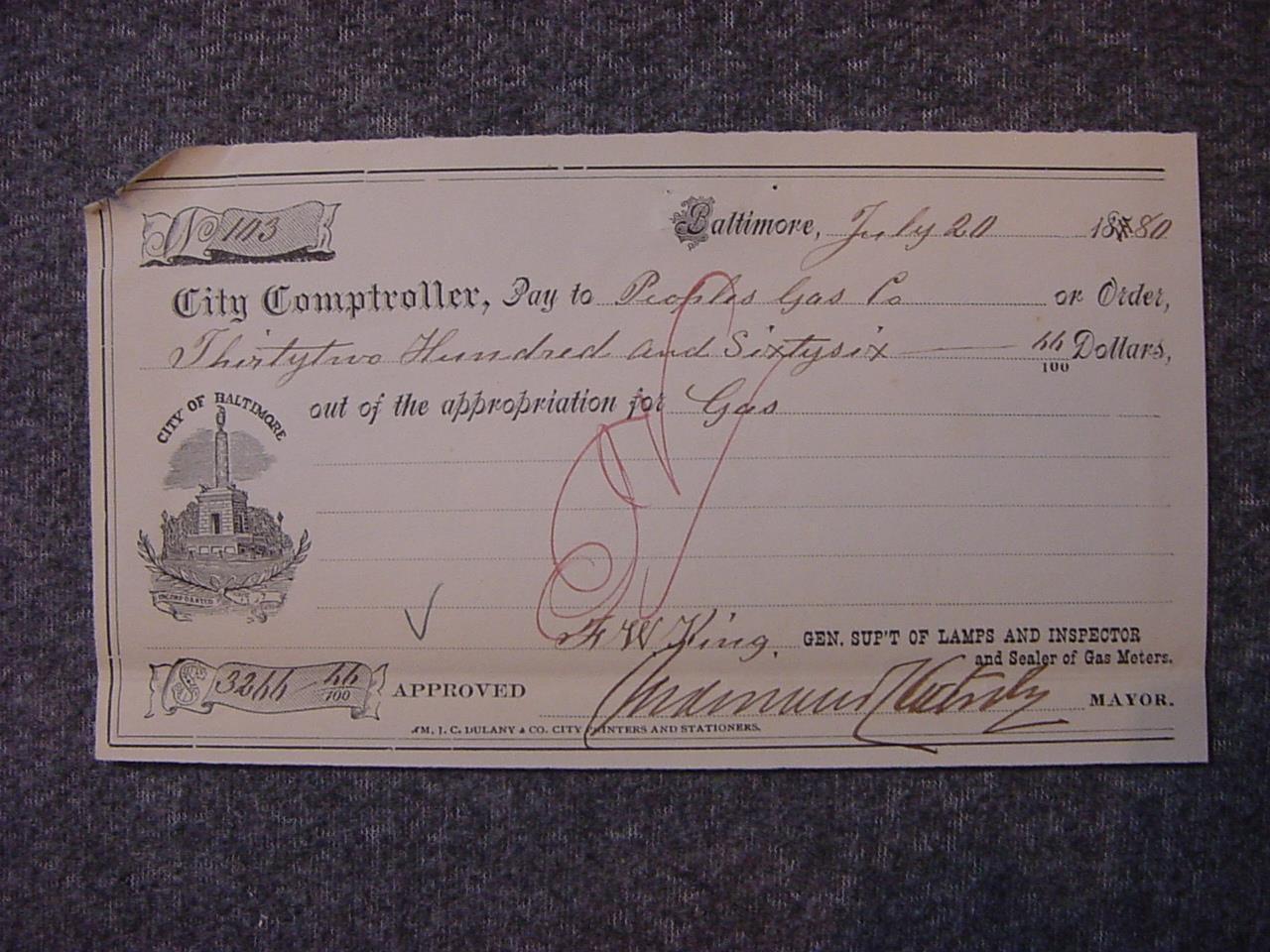
Baltimore, Maryland, Mayor Ferdinand Latrobe 1880 Signed Check
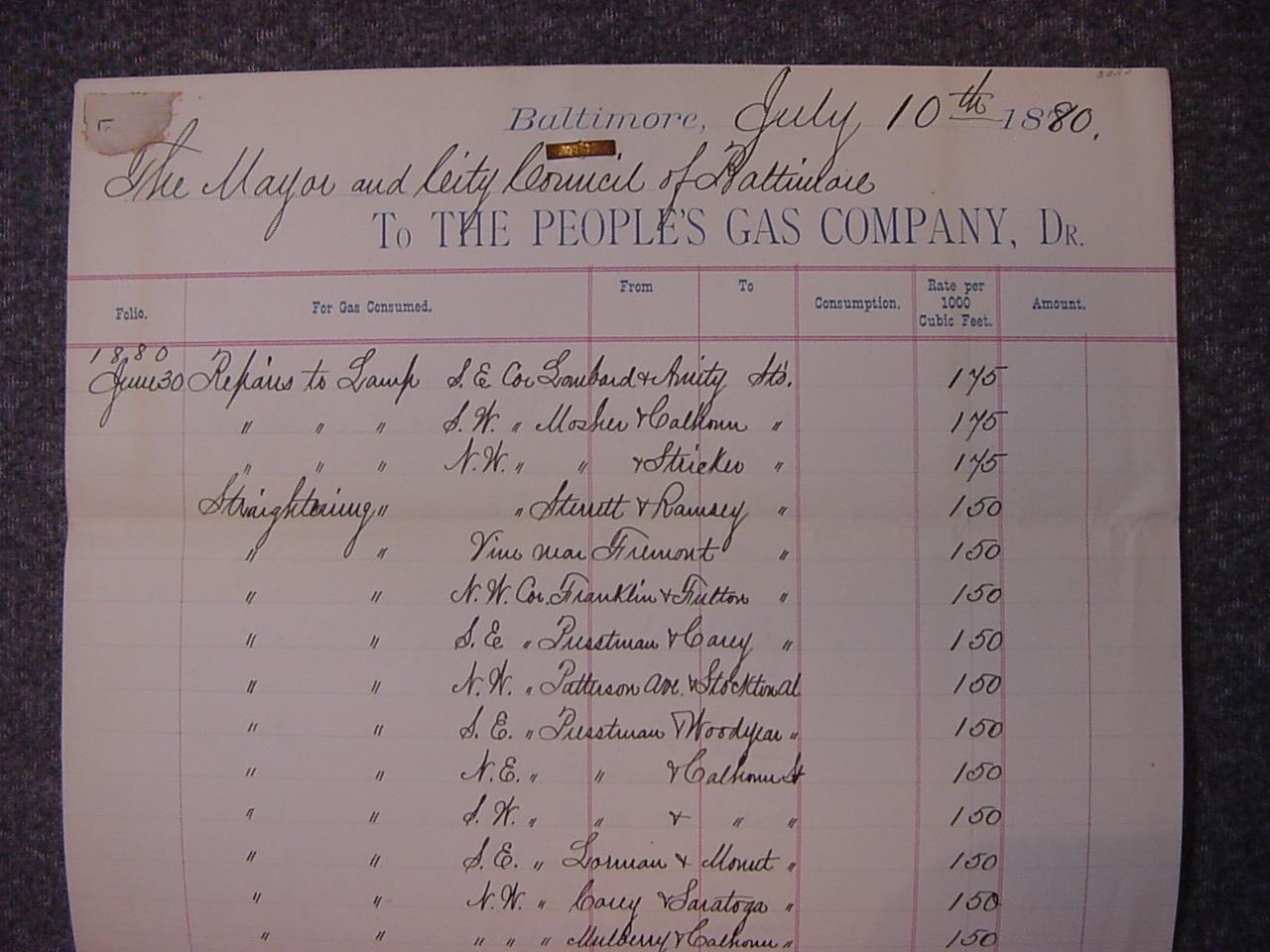
1880: The People Gas Company Baltimore
Street Lamp Maintenance Repair Upkeep & Costs Ledger
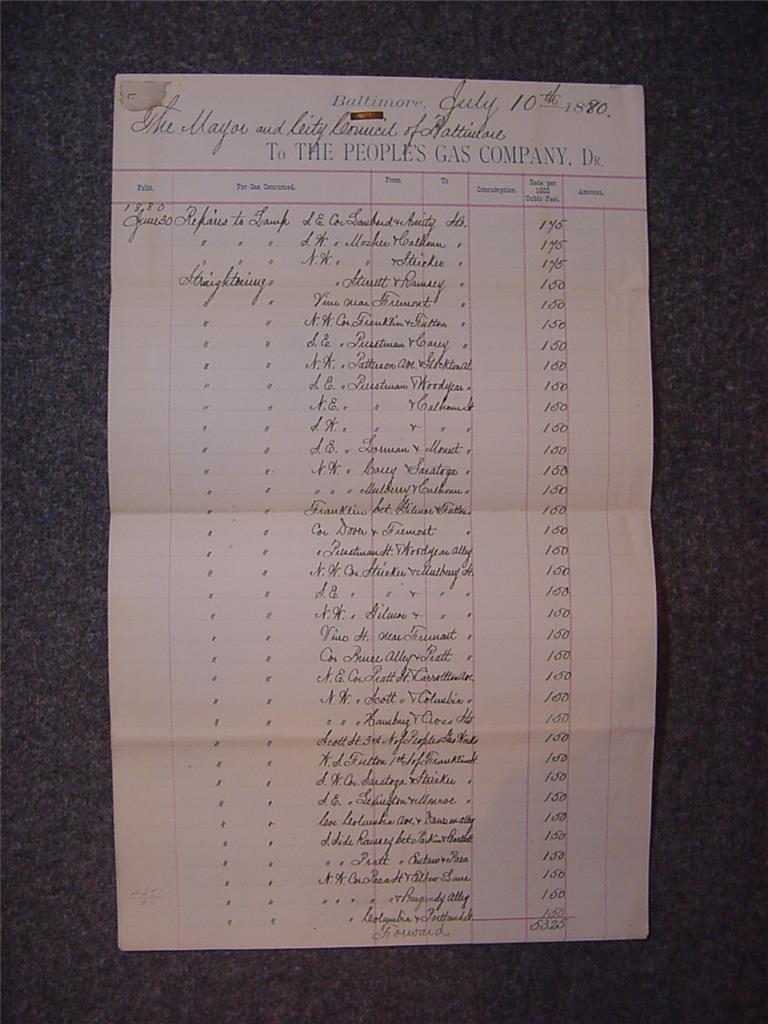
1880: The People Gas Company Baltimore
Street Lamp Maintenance Repair Upkeep & Costs
Page One Ledger
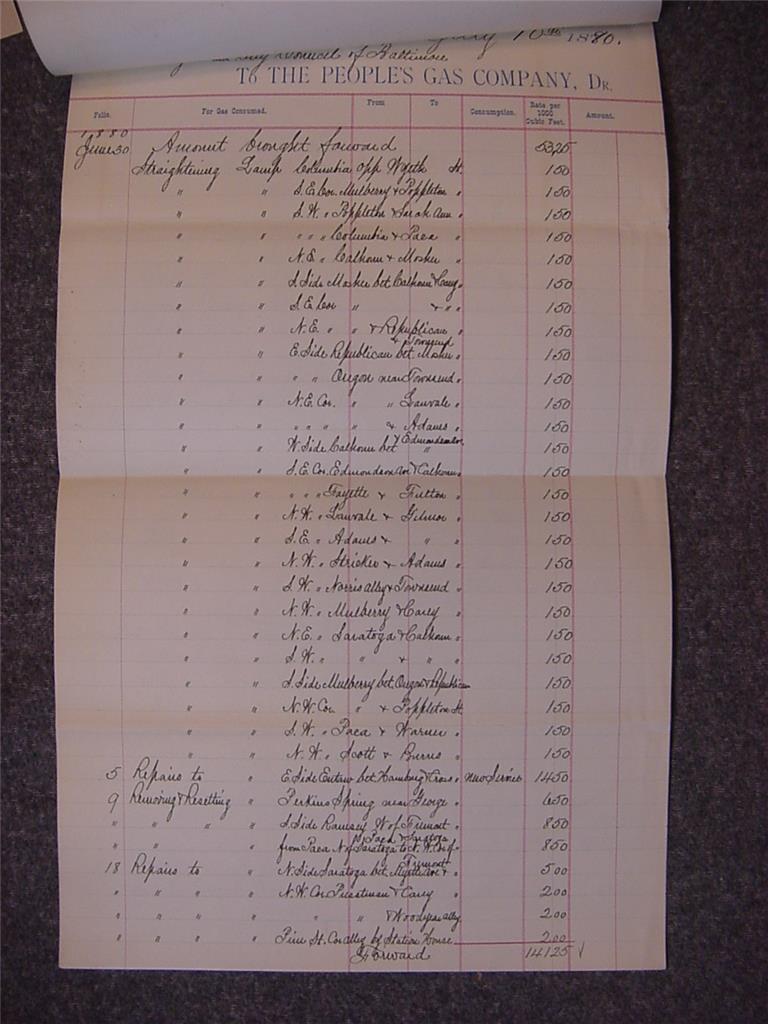
1880: The People Gas Company Baltimore
Street Lamp Maintenance Repair Upkeep & Costs
Page Two Ledger
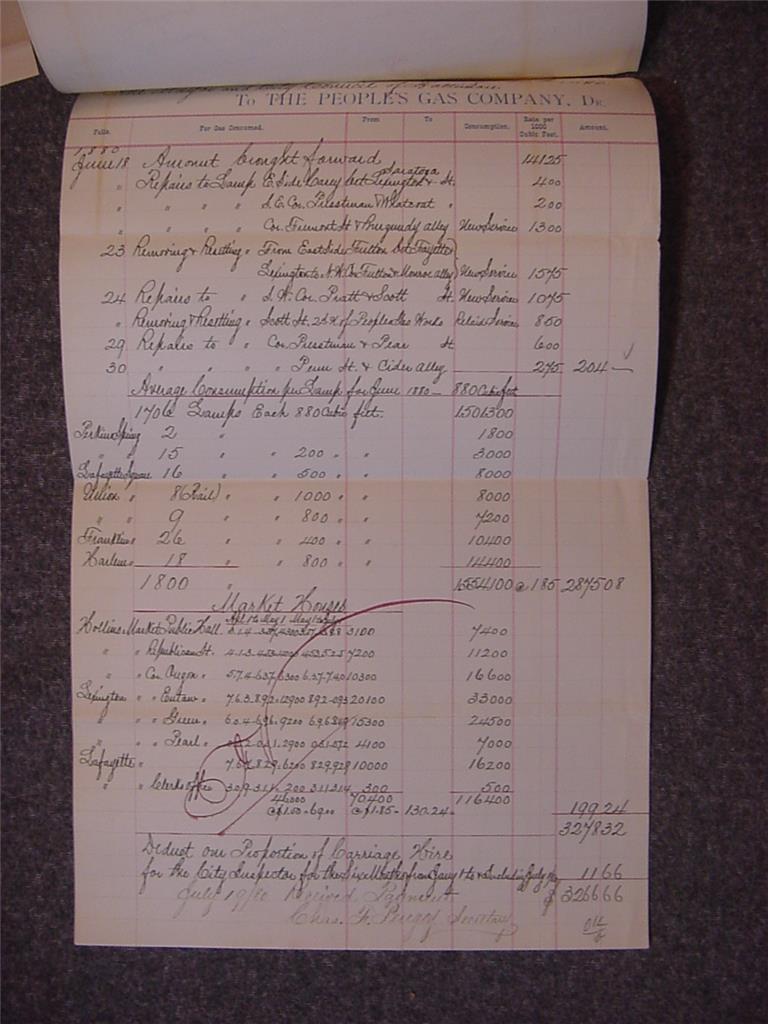
1880: The People Gas Company Baltimore
Street Lamp Maintenance Repair Upkeep & Costs
Page Three Ledger
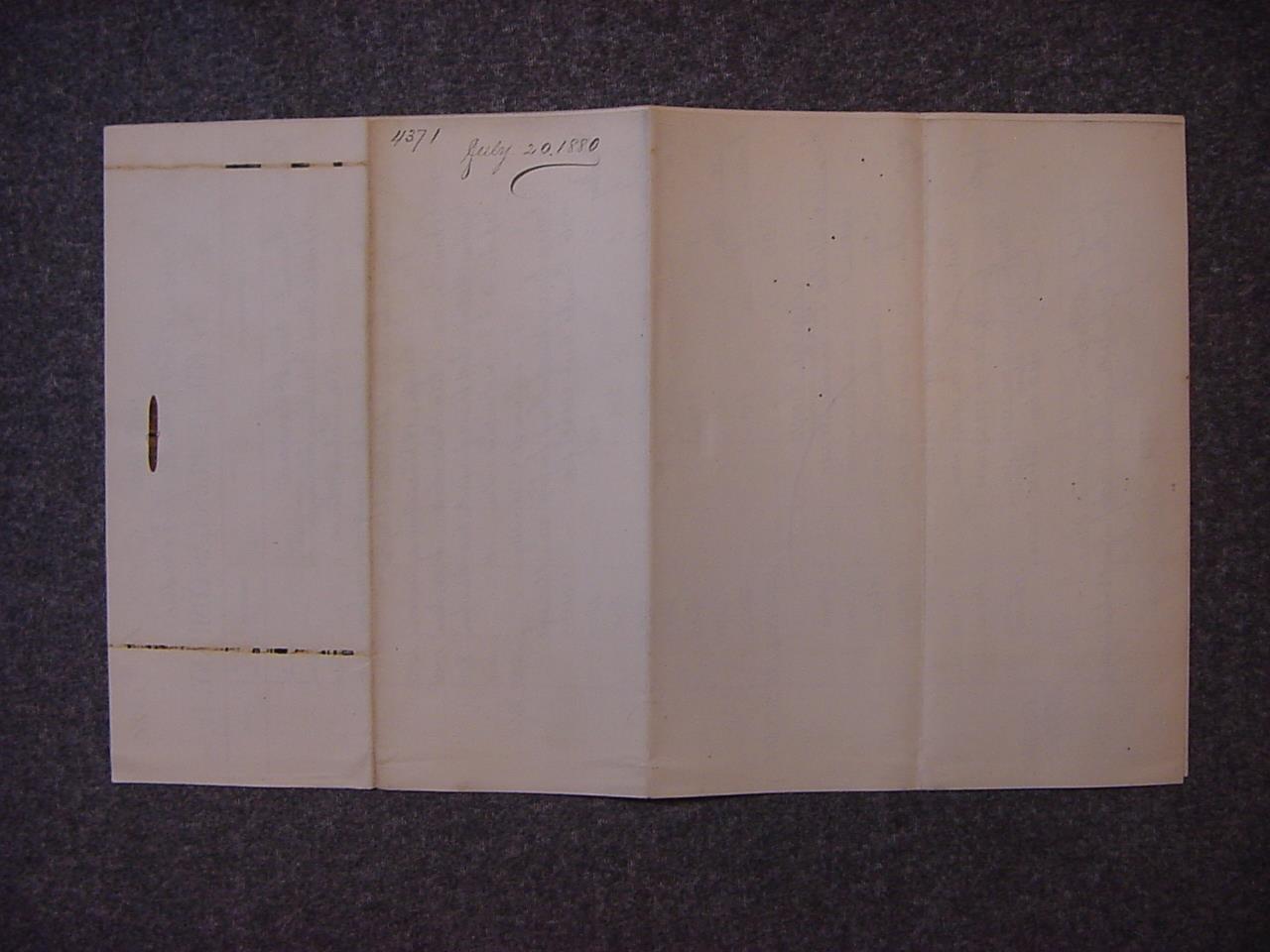
1880: The People Gas Company Baltimore
Street Lamp Maintenance Repair Upkeep & Costs
Back of Ledger
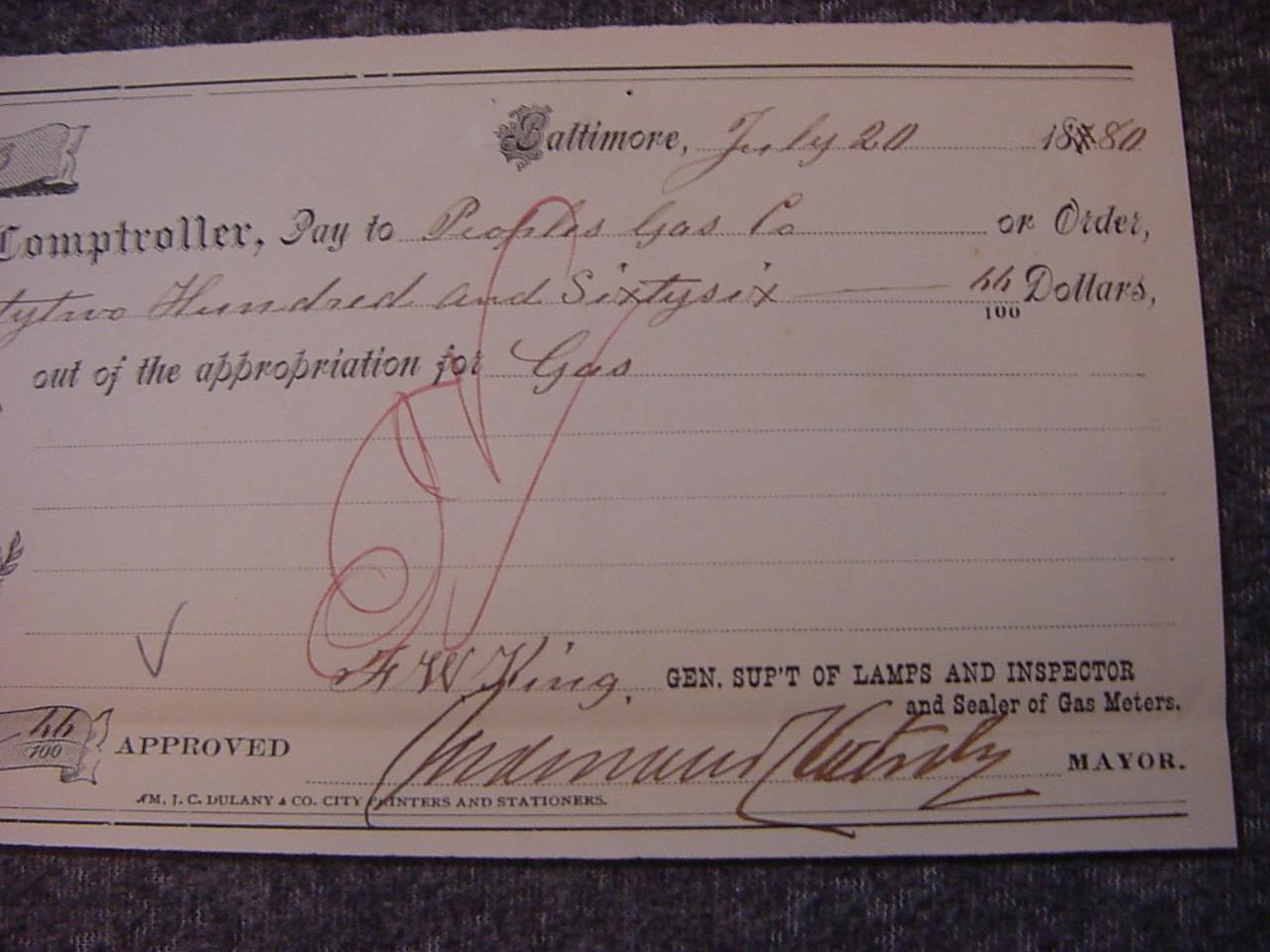
Close-up shot of Mayor Ferdinand Latrobe's 1880 Signature
![]()
NOTE: From a Baltimore Sun newspaper report dated November 29, 1856, Page 1, entitled The Re-Organization of the Police and Night Watch. We found the following article under Section 12, and it reads as follows: Section 12 provides for the appointment of a superintendent of lamps for each district, with an aggregate of forty-two lamplighters to be distributed as may be necessary. As we can see from this article, these lamp lighters started out under the authority of the Baltimore Police Department. This is interesting, as we'll see in the pictures throughout this page: Market, 1883 Lamp-Lighters Wage Sheet, Eastern District These men are associated with the Eastern District. If this is a biweekly report, the lamplighters would have been making $32 a month. What is found in this 1957 article is the listed amount made by lamplighters at the time.
How to Buy a Lamp
At the time, on August 4, 1957, it was reported on how to buy a lamp from the city. The article said, “Happily for those who have sentimental attachments to them, hundreds of the old-fashioned streetlamps will continue to burn even after Baltimore has officially abandoned their use. Walt Disney purchased 55 of them to illuminate a part of Disneyland. Sonja Henie purchased two for her home in California. Many other people all over the country have asked for some. Capping the climax out of town. A department store in New York offers “Authentic Old Baltimore Streetlamps,” complete except for the street signs and holders, for $78. As for the gas-lamp fans here at home, more than 650 Baltimoreans have found or written to Walter L. Buckingham, City Superintendent of Lighting, to inquire about the purchase procedure. Here is what he tells them: both the city and the Welsbach corporation have to be dealt with. Mr. Buckingham’s office sells the polls, and they range in price from $7.50 for the standard, simple kind to $18 for some of the more ornate kinds. The Welsbach Corporation sells the rest of the lamp, frame, lighter, globe, and dome for $16.70. The street nameplates and racks that hold them are usable on the city’s modern lamps, and as such, they were not sold. That was in 1957. Now, to buy a lamp, it is best to search Craigslist, eBay, or Facebook Market Place. I found both of mine on eBay, the first for $150 and the other for $300. The first needed parts; the second was bought for parts but came with the electric conversion kit, which in itself was valued at $300.Vintage street poles are also available from time to time and sell in the neighborhood for $300 to $600. I have seen more questions, but those high prices are rarely reached. In my opinion, the lamp is the most important part, and as such, a modern reproduction pole is not a problem for most collectors. If it were up to me, I would put more of my budget toward the lamp than the pole, but in a reproduction pole, it is important to have the ladder rack not just for looks but also for maintenance.

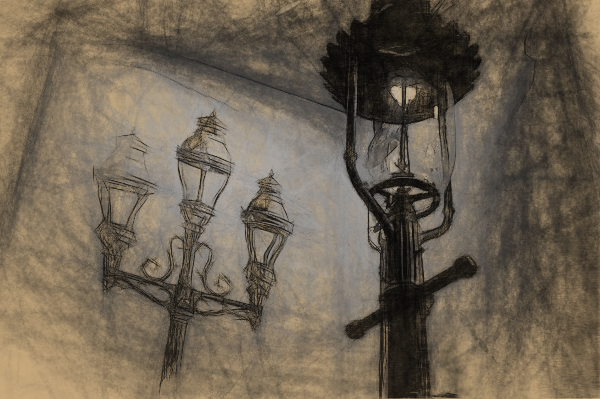
Lighting the streets
The first attempt to light the streets was in 1784, at the same time as the first attempts at paving. Then an act of assembly was passed, providing for a "Nightwatch," who were to serve as lamp-lighters and constables. The few lamps were filled with oil and burned with a feeble flame. This system continued until 1816, when a contract was made with the Baltimore Gas Light Company to light the city. Rembrandt Peel had gotten the refusal of cobblers process for making carbonated hydrogen gas; he lit his museum on Holiday Street with it, and it succeeded so well that a company was formed (Peel got 100 shares for his part—a very pretty fortune if he held them) and the city was induced to use gas, the pipes were laid down and the city was first lit with gas in 1820.
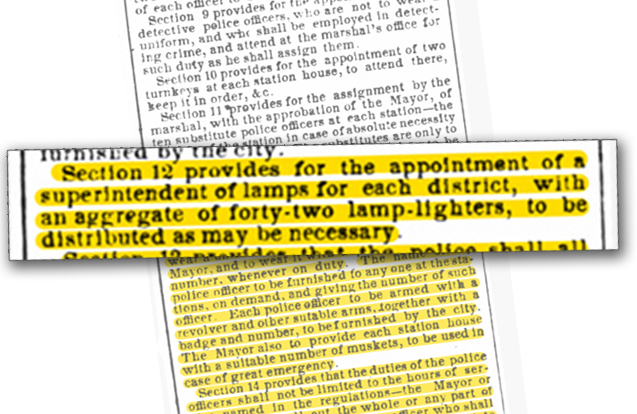
The Re-Organization of the Police and Night Watch
29 Nov 1856, p.
Section 12 provides for the appointment of a superintendent of lamps for each district, with an aggregate of forty-two lamp-lighters to be distributed as may be necessary.

The Re-Organization of the Police and Night Watch
Complete Article from November 29, 1856, p. 1: Old Baltimore Lamp Converted to Electric
Note: This information on Street Lamps shouldn't be confused with information on Recall Lamps traffic Traffic Lamps or Police Call Boxes
Good Deal Else Besides Gas Lamps
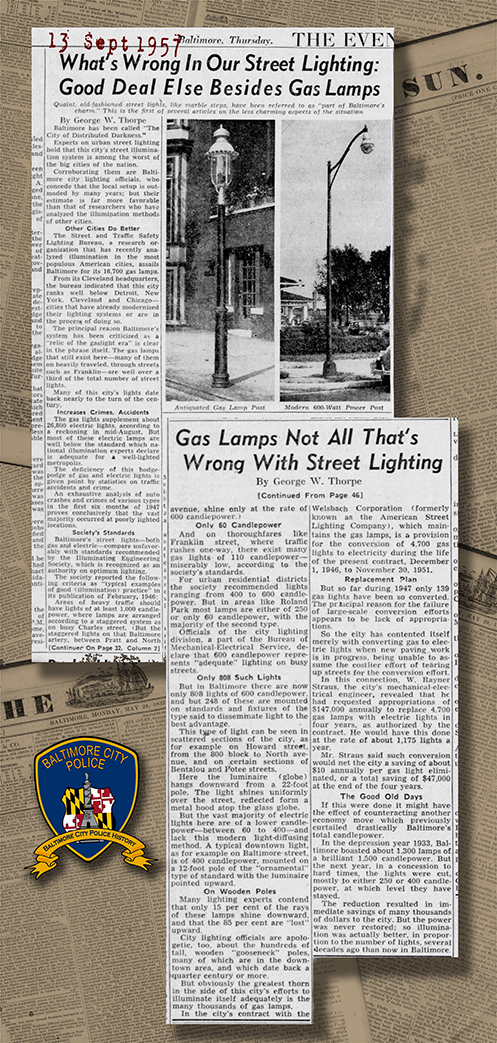 Click HERE for full-size article
Click HERE for full-size articleDonations
Donations help with web hosting, stamps and materials, and the cost of keeping the website online. Thank you so much for helping BCPH.
![]()
POLICE INFORMATION
Copies of: Your Baltimore Police Department Class Photo, Pictures of our Officers, Vehicles, Equipment, Newspaper Articles relating to our department and/or officers, Old Departmental Newsletters, Lookouts, Wanted Posters, and/or Brochures. Information on deceased officers and anything that may help preserve the history and proud traditions of this agency. Please contact retired detective Kenny Driscoll.

NOTICE
How to Dispose of Old Police Items
Please contact Det. Ret. Kenny Driscoll if you have any pictures of you or your family members and wish them remembered here on this tribute site to honor the fine men and women who have served with honor and distinction at the Baltimore Police Department. Anyone with information, photographs, memorabilia, or other "Baltimore City Police" items can contact Ret. Det. Kenny Driscoll at
Copyright © 2002 Baltimore City Police History: Ret Det. Kenny Driscoll


